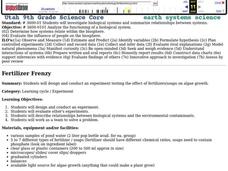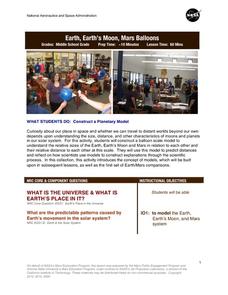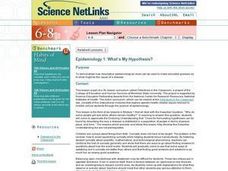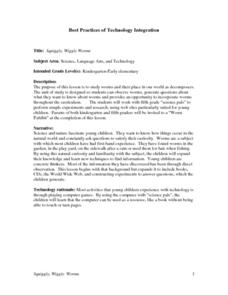Curated OER
Multiplying Microbes
Ninth graders investigate the techniques of culturing bacteria. They culture bacteria using agar plates. Students identify and describe some environmental conditions that effect bacteria growth.
Curated OER
Fertilizer Frenzy
Ninth graders design and conduct an experiment. They evaluate other's experiments. Students describe relationships between biological systems and the environmental contaminants. They work as a team to solve a problem.
Curated OER
Nature Walk
Students participate in a mini field trip around the neighborhood to observe nature and changes that are occurring during fall. They collect leaves of various colors, shapes and sizes on their trip. Upon return to the classroom, they...
Curated OER
A Sea Turtle Experience
Students observe live green sea turtles and use their imagination to form questions about the animals. They present these questions to their teacher. Students then complete the activity sheets highlighting sea turtle biology and...
Curated OER
"If you build it..."
Students utilize prior knowledge to erect and assemble a building from a drawing using spaghetti noodles and marshmallows. In this building lesson, students visualize a three dimensional structure from looking at a picture and converting...
Curated OER
Shake, Rattle, and Roll
Students make an earthquake simulator and test their structure to see if it lasts through the earthquake. In this earthquake lesson plan, students make a structure and test and record the results from an earthquake simulator made out of...
Curated OER
Houston, We Have a Problem! An Introductory Lesson for the unit Stars, Galaxies and the Universe
The lesson plan would make a stimulating introduction to a space unit. It is highly imaginative and suggests that the teacher darken the room to set the mood and dress as an astronaut. Teams are asked to help solve an imaginary problem...
NASA
Earth, Earth’s Moon, Mars Balloons
Very specific diameters are given for blowing up three different balloons to represent, in scale, the moon, Earth, and Mars. In groups of three, amateur astronomers explore scale measurements and distance in space.
Curated OER
Thinking about Energy
Students navigate through a web-based survey to help engage curiosity about energy concepts. They describe how prior perceptions influence examineing of energy concepts. They evaluate comprehension about concepts of energy.
Curated OER
INFRARED OLD FAITHFUL
Students view video clips and still images of Old Faithful and review the main questions and curiosities regarding Old Faithful. They break into groups and take on the roles of explorers and have come upon this interesting geothermal...
Curated OER
Make Sense of Nature
Students participate in this program that heightens their awareness and curiosity of nature as well as their sense of adventure and exploring new surroundings. They identify and choose an object from nature after exploring it with other...
Curated OER
Mankind's Fascination With Flight
Students discuss, examine and appreciate the science and inspiration of flight. They study the terms and mechanics of powered flight and demonstrate that the heating of air makes it lighter and therefore rise. They discuss and...
Curated OER
Mensa For Kids: The Moon
First graders explore space science by completing an arts and crafts activity. In this moon lesson, 1st graders explore the geography of the moon and discuss the importance it has for people living on Earth. Students create a replica...
Curated OER
Rover Races
Students simulate driving a rover on the surface of Mars. In this space science lesson, students identify the challenges experienced by astronauts in operating a vehicle. They recommend some changes to make their 'rover' better.
Curated OER
Noblesville Fall
Students brainstorm questions based on a given narrative about an actual fallen meteorite. In this earth science lesson, students organize their responses into different categories.
Curated OER
Where Are the Dinosaurs?
Students explore what the dinosaurs were like. In this dinosaur lesson plan, the teacher peaks student curiosity about dinosaurs. This lesson plan would be a great starting point for a dinosaur unit since it primarily engages student...
Council for the Curriculum, Examinations and Assessment
Relationships and Sexuality
Adolescence is a tumultuous time for the learners in your class. Guide them through the rocky world of friendships, risks, personal health, and emotional turmoil with a set of lessons about teenager relationships and sexuality.
Curated OER
Epidemiology 1: What's My Hypothesis?
Students demonstrate how descriptive epidemiological clues can be used to make educated guesses as to what might be the cause of a disease.
Curated OER
The Physics of Sound: How We Produce Sounds
Young scholars are introduced to how they produce sounds. In groups, they participate in experiments in which they measure sound and identify their five senses. Individually, they make their own musical instruments using different...
Curated OER
Squiggly, Wiggly Worms
Students, who are in early elementary grades, pair with fifth grade students to study worms. They observe worms in experiments, create research questions, and complete the research using Internet sites. They participate in a "Worm...
Curated OER
The Physics of Sound: How We Produce Sounds
First graders construct a KWL chart on sound. For this physics lesson, 1st graders describe different ways to produce sound. They explain how sound waves propagate.
Curated OER
Archaeological Inquiry
Students describe what they see as they observe an "artifact". They draw conclusions based on the information gathered to identify what the artifact might be used for and determine how old it might be.
Curated OER
Basic Introduction to Foundation of Life: Genes, Genetics and Genetic Diseases
Students are introduced to genetics along with genetic diseases and heredity. In groups, they complete a Punnett Square to determine the dominant and recessive genes. After viewing diagrams, they identify the characteristics of DNA and...
Curated OER
Frog Questions
In this frogs activity, students first choose a type of frog and research facts about it. Students answer 7 essay questions about habitat, food, body adaptation and protection.























